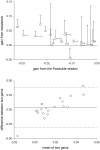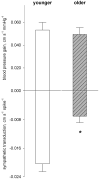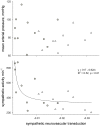Characterizing sympathetic neurovascular transduction in humans
- PMID: 23326501
- PMCID: PMC3542370
- DOI: 10.1371/journal.pone.0053769
Characterizing sympathetic neurovascular transduction in humans
Abstract
Despite its critical role for cardiovascular homeostasis in humans, only a few studies have directly probed the transduction of sympathetic nerve activity to regional vascular responses--sympathetic neurovascular transduction. Those that have variably relied on either vascular resistance or vascular conductance to quantify the responses. However, it remains unclear which approach would better reflect the physiology. We assessed the utility of both of these as well as an alternative approach in 21 healthy men. We recorded arterial pressure (Finapres), peroneal sympathetic nerve activity (microneurography), and popliteal blood flow (Doppler) during isometric handgrip exercise to fatigue. We quantified and compared transduction via the relation of sympathetic activity to resistance and to conductance and via an adaptation of Poiseuille's relation including pressure, sympathetic activity, and flow. The average relationship between sympathetic activity and resistance (or conductance) was good when assessed over 30-second averages (mean R(2) = 0.49±0.07) but lesser when incorporating beat-by-beat time lags (R(2) = 0.37±0.06). However, in a third of the subjects, these relations provided relatively weak estimates (R(2)<0.33). In contrast, the Poiseuille relation reflected vascular responses more accurately (R(2) = 0.77±0.03, >0.50 in 20 of 21 individuals), and provided reproducible estimates of transduction. The gain derived from the relation of resistance (but not conductance) was inversely related to transduction (R(2) = 0.37, p<0.05), but with a proportional bias. Thus, vascular resistance and conductance may not always be reliable surrogates for regional sympathetic neurovascular transduction, and assessment from a Poiseuille relation between pressure, sympathetic nerve activity, and flow may provide a better foundation to further explore differences in transduction in humans.
Conflict of interest statement
Figures







Similar articles
-
Sympathetic transduction in humans: recent advances and methodological considerations.Am J Physiol Heart Circ Physiol. 2021 Mar 1;320(3):H942-H953. doi: 10.1152/ajpheart.00926.2020. Epub 2021 Jan 8. Am J Physiol Heart Circ Physiol. 2021. PMID: 33416453 Free PMC article. Review.
-
Comparison of skin sympathetic nerve responses to isometric arm and leg exercise.J Appl Physiol (1985). 2004 Jul;97(1):160-4. doi: 10.1152/japplphysiol.00699.2003. Epub 2004 Mar 19. J Appl Physiol (1985). 2004. PMID: 15033962 Clinical Trial.
-
Limb blood flow and vascular conductance are reduced with age in healthy humans: relation to elevations in sympathetic nerve activity and declines in oxygen demand.Circulation. 1999 Jul 13;100(2):164-70. doi: 10.1161/01.cir.100.2.164. Circulation. 1999. PMID: 10402446
-
Relationship between regional sympathetic vascular transduction and sympathetic transduction of blood pressure in young adults at rest.Am J Physiol Regul Integr Comp Physiol. 2024 Dec 1;327(6):R528-R533. doi: 10.1152/ajpregu.00199.2024. Epub 2024 Oct 7. Am J Physiol Regul Integr Comp Physiol. 2024. PMID: 39374083
-
Differential activation of sympathetic discharge to skin and skeletal muscle in humans.Acta Physiol Scand Suppl. 1997;639:1-32. Acta Physiol Scand Suppl. 1997. PMID: 9421582 Review.
Cited by
-
Flattening the sympathetic-vascular transduction curve.Am J Physiol Regul Integr Comp Physiol. 2021 Sep 1;321(3):R482-R483. doi: 10.1152/ajpregu.00191.2021. Epub 2021 Aug 11. Am J Physiol Regul Integr Comp Physiol. 2021. PMID: 34378407 Free PMC article. No abstract available.
-
Neural control of blood pressure is altered following isolated leg heating in aged humans.Am J Physiol Heart Circ Physiol. 2020 Apr 1;318(4):H976-H984. doi: 10.1152/ajpheart.00019.2020. Epub 2020 Mar 6. Am J Physiol Heart Circ Physiol. 2020. PMID: 32142377 Free PMC article.
-
Blunted sympathetic neurovascular transduction is associated to the severity of obstructive sleep apnea.Clin Auton Res. 2021 Jun;31(3):443-451. doi: 10.1007/s10286-021-00784-8. Epub 2021 Feb 9. Clin Auton Res. 2021. PMID: 33560461
-
The impact of ageing and sex on sympathetic neurocirculatory regulation.Semin Cell Dev Biol. 2021 Aug;116:72-81. doi: 10.1016/j.semcdb.2021.01.001. Epub 2021 Jan 16. Semin Cell Dev Biol. 2021. PMID: 33468420 Free PMC article. Review.
-
Sympathetic transduction in humans: recent advances and methodological considerations.Am J Physiol Heart Circ Physiol. 2021 Mar 1;320(3):H942-H953. doi: 10.1152/ajpheart.00926.2020. Epub 2021 Jan 8. Am J Physiol Heart Circ Physiol. 2021. PMID: 33416453 Free PMC article. Review.
References
-
- Joyner MJ, Nauss LA, Warner MA, Warner DO (1992) Sympathetic modulation of blood flow and O2 uptake in rhythmically contracting human forearm muscles. Am J Physiol 263: H1078–H1083. - PubMed
-
- Kiowski W, Hulthen UL, Ritz R, Buhler FR (1983) Alpha 2 adrenoceptor-mediated vasoconstriction of arteries. Clin Pharmacol Ther 34: 565–569. - PubMed
-
- Wallin BG, Fagius J (1988) Peripheral sympathetic neural activity in conscious humans. Annu Rev Physiol 50: 565–576. - PubMed
-
- Celander O (1954) The range of control exercised by the sympathico-adrenal system; a quantitative study on blood vessels and other smooth muscle effectors in the cat. Acta Physiol Scand Suppl 32: 1–132. - PubMed
MeSH terms
LinkOut - more resources
Full Text Sources
Other Literature Sources

